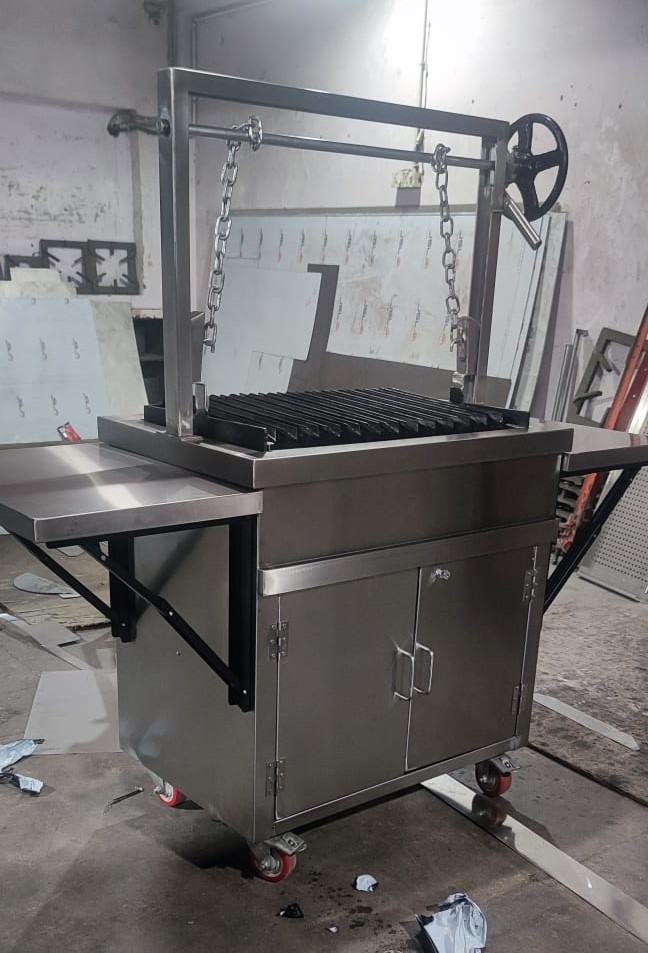Restaurant Kitchen Equipment In Delhi Restaurant kitchen equipment is essential for running an efficient kitchen, whether you're running a fast-casual spot or a fine-dining establishment. The right equipment helps streamline operations, improve food quality, and ensure safety and cleanliness. Here’s a breakdown of essential restaurant kitchen equipment: 1. Cooking Equipment Commercial Range: A versatile cooking tool with burners and sometimes an oven below. You can cook anything from soups to stir-fries. Ovens: Different types of ovens, like convection ovens, deck ovens, and pizza ovens, are essential depending on your menu. Griddles: Flat surfaces used for cooking breakfast items, burgers, and sandwiches. Deep Fryers: For frying food items like fries, chicken, and tempura. Steamers: To cook vegetables, dumplings, and seafood without drying them out. Microwaves: Commercial microwaves for reheating or quick cooking. 2. Refrigeration Equipment Reach-in Refrigerators/Freezers: These are upright units that store perishable items. Walk-in Cooler/Freezer: Larger, room-sized cooling units for bulk storage of fresh or frozen ingredients. Undercounter Refrigerators: These compact units fit under counters for easy access to ingredients during food prep. Display Refrigerators: For showcasing beverages, salads, or ready-to-eat items. 3. Food Preparation Equipment Food Processor: For chopping, slicing, dicing, or pureeing ingredients quickly. Mixers: Stand mixers or planetary mixers for mixing dough, batters, or heavy ingredients. Slicers: To slice meats, cheeses, and vegetables to consistent thickness. Blenders: High-powered blenders for smoothies, soups, and sauces. Vegetable Peelers & Graters: For prep work that requires finely shredded or peeled ingredients. Countertop Grills & Sandwich Presses: For grilling meats, sandwiches, or paninis. 4. Storage Equipment Shelving Units: To store ingredients, pots, pans, and other kitchen tools in an organized manner. Food Storage Containers: Airtight containers for storing dry ingredients or prepped food. Ingredient Bins: Large bins for flour, sugar, grains, etc. Spice Racks: To organize spices for quick access during cooking. 5. Dishwashing & Cleaning Equipment Dishwasher: Commercial-grade dishwashers with high-temperature wash cycles for cleaning large quantities of dishes, cookware, and utensils. Glasswashers: A specialized dishwasher for cleaning glassware. Trash Compactors: To compress waste and reduce volume. Garbage Disposals: Installed in sinks to easily dispose of food scraps. Mops & Floor Scrubbers: To maintain kitchen cleanliness, especially in high-traffic areas. 6. Service Equipment Prep Tables: Stainless steel tables used for food prep and assembling dishes. Holding Cabinets: To keep food at the correct temperature while waiting to be served. Food Warmer Units: To keep food warm, especially in buffet or self-service settings. Serving Utensils: Ladles, tongs, spatulas, and serving spoons for plating and serving. 7. Ventilation & Exhaust Range Hoods: Powerful exhaust systems that capture smoke, steam, and heat from cooking equipment. Grease Traps: Helps prevent grease buildup in plumbing. Air Conditioning & Ventilation: To regulate temperature and airflow in the kitchen. 8. Smallwares Cookware: Pots, pans, stockpots, saute pans, roasting pans, etc. Knives: A variety of professional knives like chef knives, paring knives, and serrated knives. Measuring Equipment: Scales, measuring cups, and spoons for consistent recipes. Cutting Boards: For prepping vegetables, meats, or fish. Utensils: Items like tongs, ladles, and whisks. 9. Beverage Equipment Coffee Machines: For brewing coffee in large volumes for service. Bar Equipment: Cocktail shakers, blenders, and refrigerators for the bar area. Ice Machines: For producing ice for beverages, food preservation, and displays. Juice Extractors: For fresh juices, common in cafes or breakfast spots. 10. Point-of-Sale (POS) System Order Entry Devices: Such as tablets or touch-screen terminals, to input customer orders. Receipt Printers: To print receipts or order tickets for the kitchen. Cash Registers or POS Systems: For billing and processing payments. 11. Safety Equipment Fire Extinguishers: Especially in areas with cooking equipment that could catch fire. First-Aid Kits: For minor kitchen injuries. Non-slip Mats: To reduce slip hazards in high-traffic areas. 12. Miscellaneous Equipment Folding Carts: For moving prepared food or heavy items across the kitchen. Heat Lamps: For keeping food hot before serving. Timers: For accurate cooking times and consistency.
Chat with us on WhatsApp
×
This is your website preview.
Currently it only shows your basic business info. Start adding relevant business details such as description, images and products or services to gain your customers attention by using Boost 360 android app / iOS App / web portal.
Restaurant Kitchen Equipment In Delhi Restaura...

2025-01-25T13:49:07
Restaurant Kitchen Equipment In Delhi Restaurant kitchen equipment is essential for running an efficient kitchen, whether you're running a fast-casual spot or a fine-dining establishment. The right equipment helps streamline operations, improve food quality, and ensure safety and cleanliness. Here’s a breakdown of essential restaurant kitchen equipment: 1. Cooking Equipment Commercial Range: A versatile cooking tool with burners and sometimes an oven below. You can cook anything from soups to stir-fries. Ovens: Different types of ovens, like convection ovens, deck ovens, and pizza ovens, are essential depending on your menu. Griddles: Flat surfaces used for cooking breakfast items, burgers, and sandwiches. Deep Fryers: For frying food items like fries, chicken, and tempura. Steamers: To cook vegetables, dumplings, and seafood without drying them out. Microwaves: Commercial microwaves for reheating or quick cooking. 2. Refrigeration Equipment Reach-in Refrigerators/Freezers: These are upright units that store perishable items. Walk-in Cooler/Freezer: Larger, room-sized cooling units for bulk storage of fresh or frozen ingredients. Undercounter Refrigerators: These compact units fit under counters for easy access to ingredients during food prep. Display Refrigerators: For showcasing beverages, salads, or ready-to-eat items. 3. Food Preparation Equipment Food Processor: For chopping, slicing, dicing, or pureeing ingredients quickly. Mixers: Stand mixers or planetary mixers for mixing dough, batters, or heavy ingredients. Slicers: To slice meats, cheeses, and vegetables to consistent thickness. Blenders: High-powered blenders for smoothies, soups, and sauces. Vegetable Peelers & Graters: For prep work that requires finely shredded or peeled ingredients. Countertop Grills & Sandwich Presses: For grilling meats, sandwiches, or paninis. 4. Storage Equipment Shelving Units: To store ingredients, pots, pans, and other kitchen tools in an organized manner. Food Storage Containers: Airtight containers for storing dry ingredients or prepped food. Ingredient Bins: Large bins for flour, sugar, grains, etc. Spice Racks: To organize spices for quick access during cooking. 5. Dishwashing & Cleaning Equipment Dishwasher: Commercial-grade dishwashers with high-temperature wash cycles for cleaning large quantities of dishes, cookware, and utensils. Glasswashers: A specialized dishwasher for cleaning glassware. Trash Compactors: To compress waste and reduce volume. Garbage Disposals: Installed in sinks to easily dispose of food scraps. Mops & Floor Scrubbers: To maintain kitchen cleanliness, especially in high-traffic areas. 6. Service Equipment Prep Tables: Stainless steel tables used for food prep and assembling dishes. Holding Cabinets: To keep food at the correct temperature while waiting to be served. Food Warmer Units: To keep food warm, especially in buffet or self-service settings. Serving Utensils: Ladles, tongs, spatulas, and serving spoons for plating and serving. 7. Ventilation & Exhaust Range Hoods: Powerful exhaust systems that capture smoke, steam, and heat from cooking equipment. Grease Traps: Helps prevent grease buildup in plumbing. Air Conditioning & Ventilation: To regulate temperature and airflow in the kitchen. 8. Smallwares Cookware: Pots, pans, stockpots, saute pans, roasting pans, etc. Knives: A variety of professional knives like chef knives, paring knives, and serrated knives. Measuring Equipment: Scales, measuring cups, and spoons for consistent recipes. Cutting Boards: For prepping vegetables, meats, or fish. Utensils: Items like tongs, ladles, and whisks. 9. Beverage Equipment Coffee Machines: For brewing coffee in large volumes for service. Bar Equipment: Cocktail shakers, blenders, and refrigerators for the bar area. Ice Machines: For producing ice for beverages, food preservation, and displays. Juice Extractors: For fresh juices, common in cafes or breakfast spots. 10. Point-of-Sale (POS) System Order Entry Devices: Such as tablets or touch-screen terminals, to input customer orders. Receipt Printers: To print receipts or order tickets for the kitchen. Cash Registers or POS Systems: For billing and processing payments. 11. Safety Equipment Fire Extinguishers: Especially in areas with cooking equipment that could catch fire. First-Aid Kits: For minor kitchen injuries. Non-slip Mats: To reduce slip hazards in high-traffic areas. 12. Miscellaneous Equipment Folding Carts: For moving prepared food or heavy items across the kitchen. Heat Lamps: For keeping food hot before serving. Timers: For accurate cooking times and consistency.
2025-01-25T13:49:07
Keywords
- professional knives
- serving spoons
- smoothies soups
- essential depending
- youre running
- pizza ovens
- stirfries ovens
- serving timers
- pos systems
- order tickets
- print receipts
- touchscreen terminals
- producing ice
- brewing coffee
- tongs ladles
- regulate temperature
- correct temperature
- easily dispose
- compress waste
- specialized dishwasher
- dishes cookware
- quick access
- organize spices
- spice racks
- prep work
- planetary mixers
- easy access
- bulk storage
- tempura steamers
- fries chicken
- ensure safety
- finedining establishment
- fastcasual spot
- food warm
- food prep
- large volumes
- utensils glasswashers
- upright units
- cleanliness heres
- kitchen tools
- efficient kitchen
- heavy items
- cooking equipment
- cook vegetables dumplings
- kitchen heat lamps
- heavy ingredients slicers
- fresh juices common
- frying food items
- fish utensils items
- maintain kitchen cleanliness
- restaurant kitchen equipment
- prepping vegetables meats
- storing dry ingredients
- keeping food hot
- moving prepared food
- beverages food preservation
- cleaning large quantities
- compact units fit
- accurate cooking times
- kitchen cash registers
- versatile cooking tool
- reduce slip hazards
- displays juice extractors
- capture smoke steam
- hightemperature wash cycles
- flour sugar grains
- grilling meats sandwiches
- requires finely shredded
- slice meats cheeses
- mixing dough batters
- chopping slicing dicing
- showcasing beverages salads
- microwaves commercial microwaves
- sandwiches deep fryers

Submit Your Enquiry